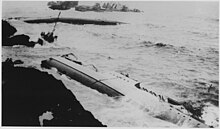USSDelphy
 USSDelphyat Boston Navy Yard on 28 October 1919
| |
| History | |
|---|---|
| Name | Delphy |
| Namesake | Richard Delphy |
| Builder | Bethlehem Shipbuilding Corporation,Squantum Victory Yard |
| Laid down | 20 April 1918 |
| Launched | 18 July 1918 |
| Commissioned | 30 November 1918 |
| Decommissioned | 26 October 1923 |
| Fate |
|
| General characteristics | |
| Class and type | Clemson-classdestroyer |
| Displacement | 1,190 tons |
| Length | 314 ft 5 in (95.8 m) |
| Beam | 31 ft 8 in (9.7 m) |
| Draft | 9 ft 3 in (2.8 m) |
| Propulsion |
|
| Speed | 35knots(65 km/h; 40 mph) |
| Range | 4,900nmi(9,100 km; 5,600 mi) at 15 knots (28 km/h; 17 mph) |
| Complement | 120 officers and enlisted |
| Armament |
|
USSDelphy(DD-261)was aClemson-classdestroyerin theUnited States NavyfollowingWorld War I.It was theflagshipof the destroyer group involved in theHonda Point disaster.
Namesake
[edit]Richard Delphy was born c. 1795. He was appointedMidshipmanon 18 May 1809 and served during the engagement withHMSMacedonianon 25 October 1812. He was killed in the action in whichUSSArguslost toHMSPelicanon 14 August 1813.
History
[edit]Delphywaslaunchedon 18 July 1918 byBethlehem Shipbuilding Corporation,Squantum, Massachusetts;sponsored by Mrs. W. S. Sims, wife of Rear AdmiralWilliam Sims;andcommissionedon 30 November 1918.
Before joining theAtlantic FleetDelphytestedsubmarinedetection devices atNew London, Connecticut,from 23 to 31 December 1918 and aided survivors fromNorthern Pacific,stranded offFire Island, New York,on New Year's Day, 1919.Delphysailed from New York on 13 January for winter maneuvers and torpedo practice in theCaribbean Sea.Returning to New York on 14 April with the Fleet, she sailed forBoston,Massachusetts, on the last day of the month for operations in preparation for the firsttransatlantic seaplaneflight.
Delphysailed 19 November 1919 from Boston for the west coast, arriving atSan Diego, California,on 22 December. She joined Destroyer Squadrons,Pacific Fleet,at San Diego for torpedo practice and recovery until placed in reserve on 12 June.Delphylay at San Diego until 27 December when she sailed with the other ships of Reserve Destroyer Division forBremerton, Washington,arriving on 4 January 1921 for an extended overhaul atPuget Sound Navy Yard.
Honda Point
[edit]
Between 22 July 1921 and 20 March 1922Delphyoperated from San Diego with 50 percent of hercomplement,and then was overhauled. She cruised with theBattle Fleetfor exercises offBalboafrom 6 February to 11 April 1923, and then carried out experiments with torpedoes off San Diego. On 25 June she got underway with Destroyer Division 31 for a cruise toWashingtonfor summer maneuvers with the Battle Fleet on the return passage.
Delphy,under the command ofLieutenant CommanderDonald T. Hunter, was the leading destroyer of seven which were stranded on the rocks of theCaliforniacoast in dense fog on 8 September 1923.[1]This event became known as theHonda Point disaster.Delphycrashed broadside and broke in half, her stern below the surface. Three of her crew died and 15 were injured.
She wasdecommissionedas of 26 October 1923, and sold as a wreck 19 October 1925.
As of 2007, no other US Navy ships have been namedDelphy.
Notes
[edit]- ^ Charles Hocking (1990).Dictionary of Disasters at Sea During The Age of Steam.The London Stamp Exchange, London.ISBN0-948130-687.,184.
References
[edit] This article incorporates text from thepublic domainDictionary of American Naval Fighting Ships.The entry can be foundhere.
This article incorporates text from thepublic domainDictionary of American Naval Fighting Ships.The entry can be foundhere.
